100 Architecture Terms That Will Help You Describe Buildings Better

Drawings: Samantha Pires/My Modern Met
Are you an architecture fan? Whether you are an architectural designer yourself or just an architecture lover, you may have noticed that there are a lot of specific and technical terms that come with talking about buildings. That is why My Modern Met has put together a helpful list of 100 architecture terms to help you describe buildings better.
Some of these terms describe popular styles of architecture. Others describe specific terms that you may recognize but did not know what the design element was called. Though this is not a conclusive list, it is a great range of terms that might open you up to new styles and concepts related to architecture. Keep reading to see how many terms you recognize!
Here are 100 architecture terms that will help you describe buildings better!
Amphitheatre
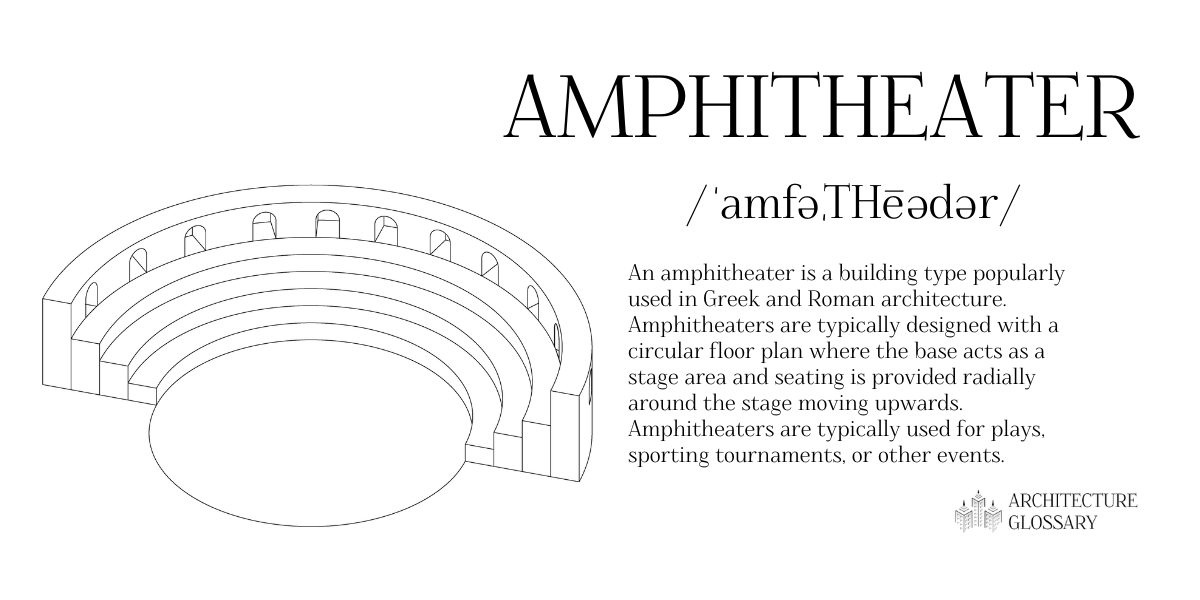
Drawings: Samantha Pires/My Modern Met
An amphitheater is a building type popularly used in Greek and Roman architecture. Amphitheaters are typically designed with a circular floor plan where the base acts as a stage area and seating is provided radially around the stage moving upwards. Amphitheaters are typically used for plays, sporting tournaments, or other events.
Arcade
In architecture, an arcade is a defined passageway that can be marked in a few different ways. Arcades can be the passageway under a series of arches, the area between arches and a wall, or just a covered walkway between arches. Arcades can happen on the exterior as a semi-enclosed space or on the interior.
Arch
An arch is a form of structure found throughout much of architecture. It uses a curve to span a space from two points. There are a few different kinds of arches and they can be made in many materials, but the core structural concept is always the same.
Art Deco
Art Deco architecture is a unique building aesthetic that came about during the larger Art Deco movement around the 1920s. It features glamorous detailing with often geometric façades and signature vintage fonts. Though the style was short-lived, it remains an iconic and recognizable aesthetic.
If you want to learn more about Art Deco architecture, be sure to read our guide: 5 Art Deco Buildings That Embody the Vintage Glamour of This Architectural Style
Art Nouveau
Art Nouveau architecture is a design style that sought to create one unified style that blurred the line between architecture, interior design, furniture design, painting, and more. Designers of Art Nouveau architecture would try to create a “complete work.” These works were often very cohesive in their design style and intricately detailed. You can recognize Art Nouveau architecture for its romantic detailing, metalwork, and integration of sculpture.
If you want to learn more about Art Nouveau architecture, be sure to read our guide: 5 Art Nouveau Buildings That Embody the Elegance of This Architectural Style
Arts and Crafts
The Arts and Crafts movement was a trend in architecture and design that pushed back against the industrial revolution. While earlier trends tried to modernize and standardize good design, this trend celebrated handmade things and tried to inspire more creativity. Though the trend was present in architecture, it can be found in many other art forms of the time as well.
Atrium
An atrium is any interior volume in a building. Atriums are similar to interior courtyards but they are typically enclosed and conditioned as opposed to open to the elements. These spaces are often a major feature and shared space in a building.
Barrel Vault
A barrel vault is a simple form of a vault—or extruded arch. Barrel vaults are a continuous extrusion though some vaults featured ornamentation along the surface instead of a plain extrusion.
Belfry
The belfry is where the bell can be found in a bell tower—also where Quasimodo lived in The Hunchback of Notre Dame. A belfry is a common feature in old churches.
Béton brut
Béton brut translates to “raw concrete” from the original French. It refers to the aesthetic of unfinished concrete after being removed from formwork. This is an important term because the appearance of béton brut was a major pinnacle of modernism. Specifically, the aesthetic of béton brut led to the architectural style of Brutalism—and also gave the popular style its name.
Biomimicry
Biomimicry is when architecture copies processes or forms found in nature. Biomimicry is used in architecture both for aesthetics and for buildings functions. A building’s system for conditioning air might mimic a forest for efficiency. Columns may be designed to look like trees simply for aesthetics.
Biophilia
Biophilia is the idea that humans have a natural desire to be surrounded by nature. Designers often use the hypothesis of biophilia as a directive, meeting this desire by introducing a visual or physical connection to nature within or near a building.
Bracing
Bracing is reinforcement to a structural system. One form of bracing is cross bracing which features two members organized in an X-shape so that one deals with tension and the other with compression.
Brise Soleil
Brise soleil, or brise-soleil, is a French term that translates to “sun breaker.” It refers to deflecting the sunlight that heats a building to naturally cool the interior. One popular form of deflecting sunlight is through louvers, another term on this list.
Brutalism
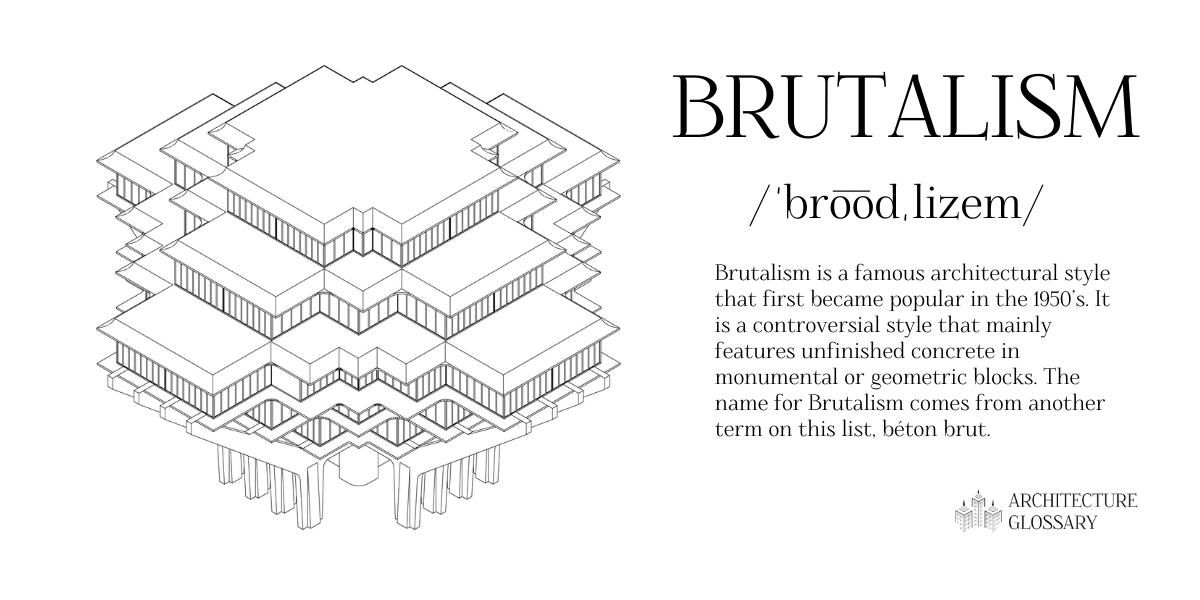
Drawings: Samantha Pires/My Modern Met
Brutalism is a famous architectural style that first became popular in the 1950s. It is a controversial style that mainly features unfinished concrete in monumental or geometric blocks. The name for Brutalism comes from another term on this list, béton brut.
If you want to learn more about Brutalist architecture, be sure to read our guide: Brutalism: What Is It and Why Is It Making a ComeBack?
Buttress
A buttress is a form of structure that helps to reinforce a wall. Buttresses are built against the wall—or near the wall, and they reach across to help support the wall. There are a few different kinds of buttresses, including flying buttresses which are defined later in this list.
Byzantine Architecture
Byzantine architecture is a style of architecture that celebrated advancing technology and glamorous detailing. It became popular under Emperor Justinian in the 6th century. One of the most famous examples of Byzantine architecture is Hagia Sophia, which features all the popular characteristics of the style including a higher than usual dome and dramatic ornamentation.
If you want to learn more about the Hagia Sophia, be sure to read our guide: What is Hagia Sophia? Learn How This Sacred Space Has Evolved Over Its Long History
Canopy
A canopy is the cantilevering coverage of an outside area. Canopies are often built over entrances to shelter people from rain or to provide them with shade. Though some canopies are simple coverings, some architects turn canopies into beautiful installations and works of art with a range of materials.
Cantilever
A cantilever is the portion of a building that protrudes out. Some cantilevers are simple, like when a deck pushes out just a bit past the last beam. Other examples of a cantilever can be extreme—like when massive portions of a building seem to defy gravity with no support where it cantilevers. The common rule for cantilevers is 1/3 of a section can overhang and 2/3 of a section is supported.
Caryatid
Caryatids are an iconic part of ancient Greek architecture. A caryatid is a sculptural column in the form of a woman. One of the most well-known uses of caryatids is on the porch of the Erechtheion in Athens, Greece.
If you want to learn more about caryatids, be sure to read our guide: How Caryatids Have Beautifully Blended Sculpture and Architecture Since Ancient Times
Circulation
In architecture, circulation refers to the pathways that people use to get around a building. Circulation is made up of hallways, paths people take to cross a room, and any other way people experience the architecture. Circulation also includes the way people move around the outside of a building.
Classical
Classical architecture refers to Greek and Roman architecture of classical antiquity. These classical buildings influenced countless design ideas that came after and are still frequently used in public buildings around the world.
Colonial Architecture
Colonial architecture can mean a few different design styles. It happens when a country is colonized and begins to use architecture from the country colonizing it. At times, the resulting design style is a replica of ideas from the mother country; other times, it is an interesting combination of both countries’ aesthetics.
Contemporary
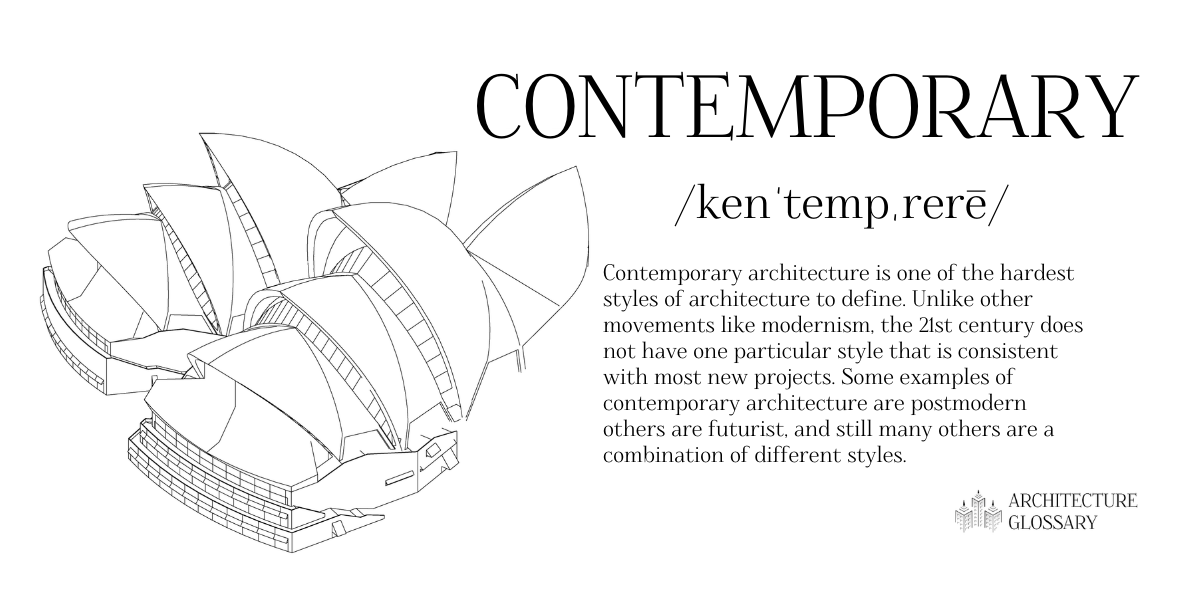
Drawings: Samantha Pires/My Modern Met
Contemporary architecture is one of the hardest styles of architecture to define. Unlike other movements like modernism, the 21st century does not have one particular style that is consistent with most new projects. Some examples of contemporary architecture are postmodern others are futurist, and still many others are a combination of different styles.
Context
In architecture, context refers to the area around an architectural project. It is an important idea to understand because many architects believe that their buildings should fit well into the context. “Context plans” is a site plan that shows the larger area—or context—surrounding a project.
Context can also refer to the conceptual related areas instead of a physical place. For example, someone might talk about a building’s relationship to historical context.
Corbusian
Corbusian is an adjective used to describe architecture of the same style of Le Corbusier. Le Corbusier was the popular name for Swiss architect Charles-Édouard Jeanneret, one of the most famous architects to ever live. His modernist style was based on ideas of functionalism and some ideas that follow this logic are sometimes referred to as Corbusian.
Core
In architecture, a core is a vertical void in a building that can serve a few different purposes. A circulation core is the vertical grouping of an elevator, stair, or pair of the two. A core can also refer to a service core that is vertically continuous throughout the building. If you look at a series of floor plans of a building, you may be able to spot the core by finding the continuous program at the same spot on each floor—for example, the size and location of the stairs should generally stay the same for many levels.
Corinthian
The Corinthian order is one of three classical orders in Ancient Greek and Roman architecture. It is the most elaborate of all three orders and was the last developed. The orders are easiest to distinguish by the ornamentation found in the column heads.
Cruciform
Cruciform means taking the form of a cross. This is a common term in architecture because many buildings—especially cathedrals and churches—are designed with cruciform floor plans.
Curvilinear
Curvilinear architecture includes curved lines. It is often understood as the opposite of rectilinear which is also defined on this list.
Deconstructivism
Deconstructivism is one form of Postmodern architecture. It is defined by fragmented and distorted architectural elements. The most famous example of deconstructivism is by starchitect Frank Gehry.
See more examples of deconstructivism: 10 Influential Buildings by Postmodern Architect Frank Gehry
Diagram
A diagram is a simplified drawing that helps break down concepts. Though diagrams are used in many fields other than architecture, diagrams are an important part of architecture drawings. They help break down ideas as broad as a concept behind a building to as detailed as mechanical systems in a project.
Dome
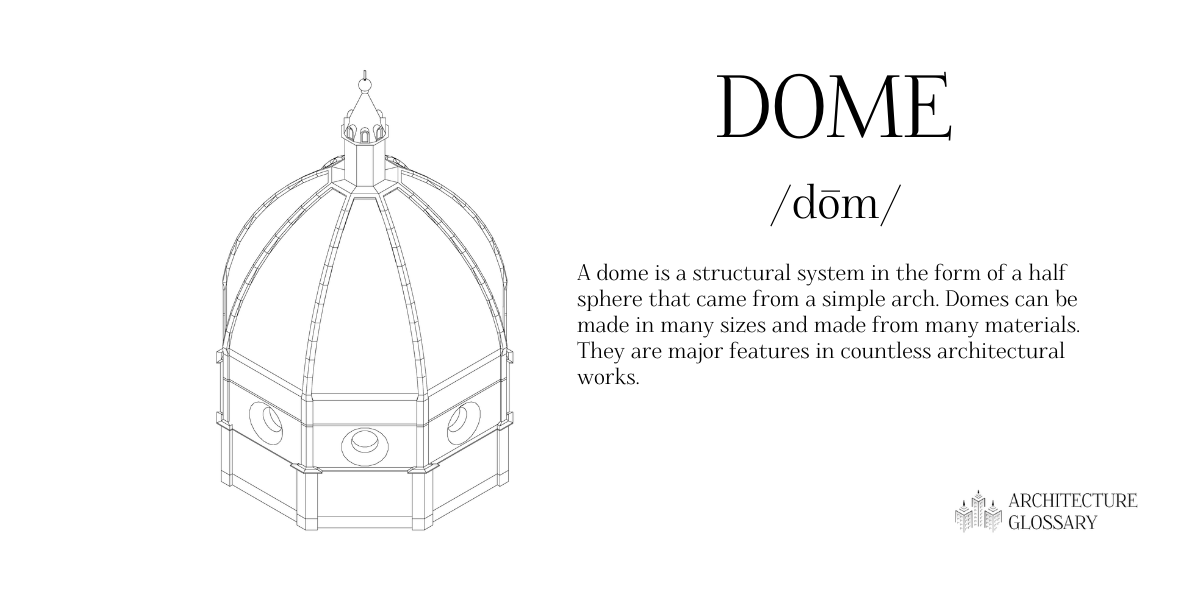
Drawings: Samantha Pires/My Modern Met
A dome is a structural system in the form of a half sphere that comes from a simple arch. Domes can be made in many sizes and from many materials. They are major features in countless architectural works.
Doric
The Doric order is one of three classical orders in Ancient Greek and Roman architecture. It is the simplest of all three orders and was the first to be developed. The orders are easiest to distinguish by the ornamentation found in the column heads. In this case, the column head has little ornamentation.
Egress
Building egress is the pathways people take to safely exit a building. It includes vertical circulation, hallways, and any other movements people take to exit. Designing the egress of a building is a critical consideration for architects.
Elevation
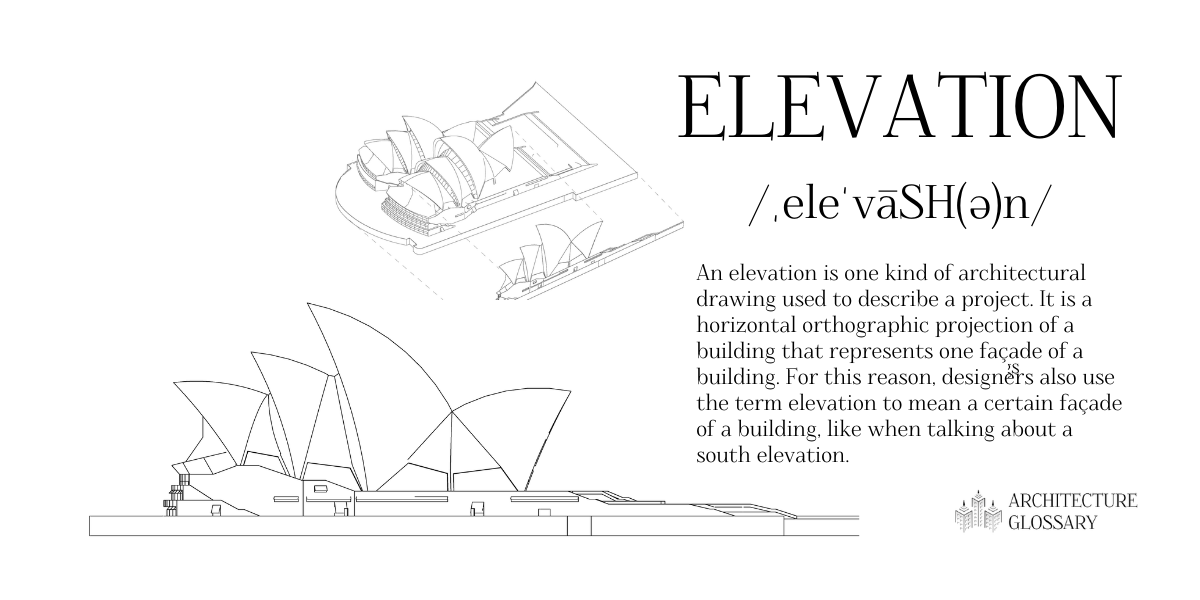
Drawings: Samantha Pires/My Modern Met
An elevation is one kind of architectural drawing used to describe a project. It is a horizontal orthographic projection of a building that represents one façade of a building. For this reason, designers also use the term elevation to mean a certain façade of a building, like when talking about a south elevation.
Envelope
In architecture, a building envelope refers to the exterior walls of a building. It includes all exterior walls, roof systems, apertures, and anything else that separates the interior of the building from the exterior of the building.
Fabrication
Fabrication refers to the way things are put together in architecture. Contemporary methods of fabrication include 3D printing and the use of robotics, but the term refers to any way of building of a physical object.
Façade
In architecture, a façade is a face of the building. Façades are also sometimes referred to as an elevation, a concept described earlier on this list.
Fenestration
In architecture, fenestration is the combination of windows and doors on a façade and how they are arranged on a building. While these openings serve an obvious functional purpose, there is a lot of room for design in the fenestration of a building.
Floor Plan
A floor plan is one of the most critical forms of architectural drawing. It is the representation of a work from above that cuts through walls to show the clearest representation of all spaces. Many floor plans are labeled to best show the functions of each space. Other common details include the swinging directions of doors, entry, vertical circulation, wall thicknesses that designate material, window cut outs, and furniture.
Flying Buttress

Drawings: Samantha Pires/My Modern Met
The flying buttress is a specific kind of buttress that is built on a separate pier and connects to the wall that it supports. The term flying describes the fact that it is not built against the wall it supports—as in a traditional buttress as defined earlier in this list—and instead connects using an arch that “flies” from the pier to the connecting wall.
Free Plan
A free plan, or “open plan” as it is sometimes called, is when a floor plan is carefully designed to limit the need for load-bearing walls. The major load is carried by the outer walls and columns carry the rest. The open plan allows for more freedom since there are no extra walls to limit design.
French Door
French doors are a pair of wooden doors with large glass areas that extend most of the height. The glass on the doors are typically divided into smaller panels. French doors are typically in pairs (but not always) and they are often used to separate a back entry or other interior condition, since they do not offer much privacy as a front door.
Frieze
A frieze is a common design element in classic architecture. It is a long, thin area between the cornice and the column capitals and is covered in sculptural elements.
Gable
A gable is the triangular portion between intersecting roof pitches. Gable roofs are efficient because the steep slope allows for water to drain easily and for better interior ventilation.
Gentrification
Gentrification is when the unique qualities of an urban area are lost and appropriated when wealthier people begin to move in. The area begins to change and the current residents are priced out. Though it is not a purely architectural term, gentrification affects the urban environment and the buildings built there.
If you want to learn more about climate gentrification, be sure to read our article: An Introduction to ‘Climate Gentrification’ and the Rising Prices of Higher Ground
Gothic
Gothic architecture is a popular style mainly found in Europe in the 12th and 16th centuries. It is characterized by rib vaults, ornate tracery, and flying buttresses—all terms we define here on this list.
If you want to learn more about Gothic architecture, be sure to read our guide: 5 Awe-Inspiring Gothic Cathedrals That Celebrate the Flamboyant Architectural Style
Groin Vault
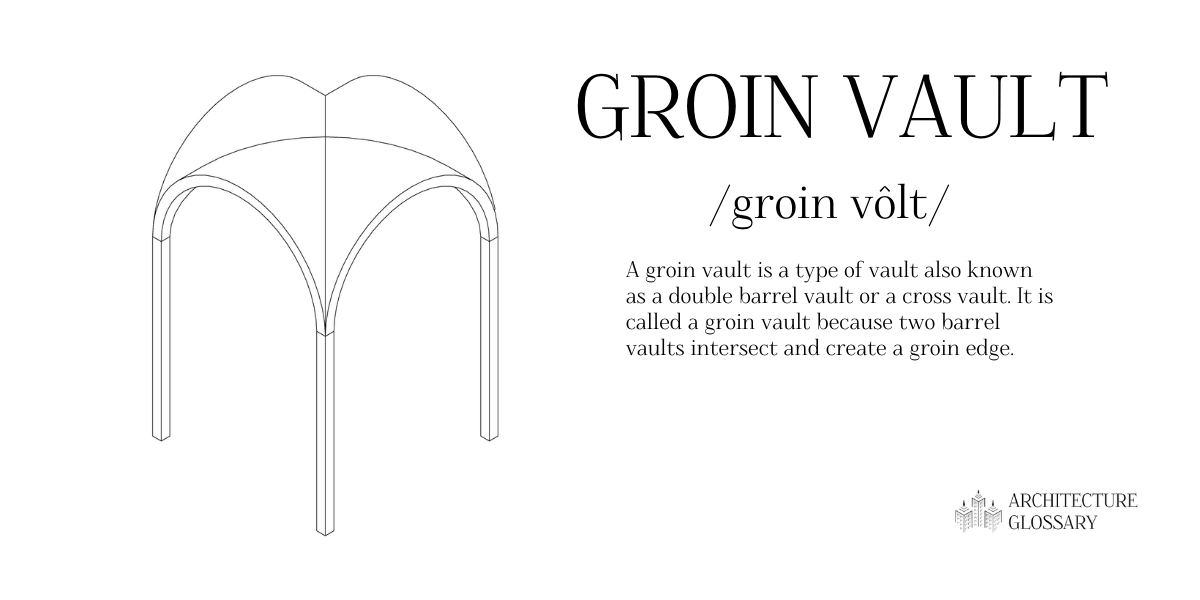
Drawings: Samantha Pires/My Modern Met
A groin vault is a type of vault also known as a double barrel vault or a cross vault. It is called a groin vault because two barrel vaults intersect and create a groin edge.
Industrial
Industrial is a term often used to define contemporary projects with lots of steel, sleek polished surfaces, clean angular lines, and industrial style materials.
Ionic
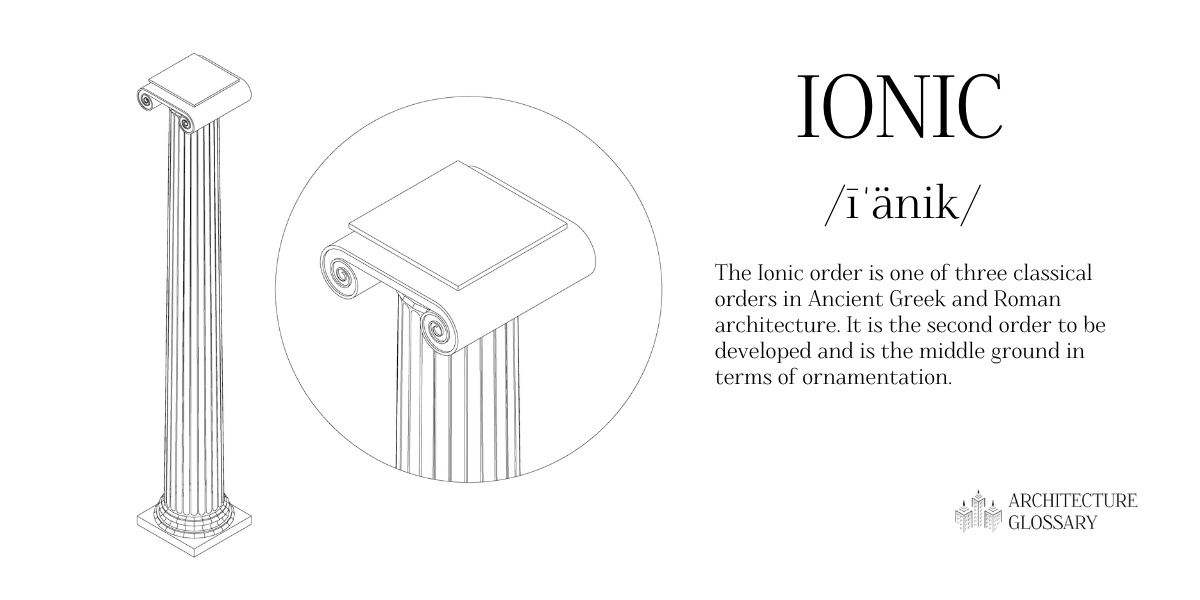
Drawings: Samantha Pires/My Modern Met
The Ionic order is one of three classical orders in Ancient Greek and Roman architecture. It is the second order to be developed and is the middle ground in terms of ornamentation.
Isometric
Isometrics are a form of architectural drawing that helps represent 3D objects in 2D drawings. It allows for an easily understandable view of a simple perspective.
Juxtaposition
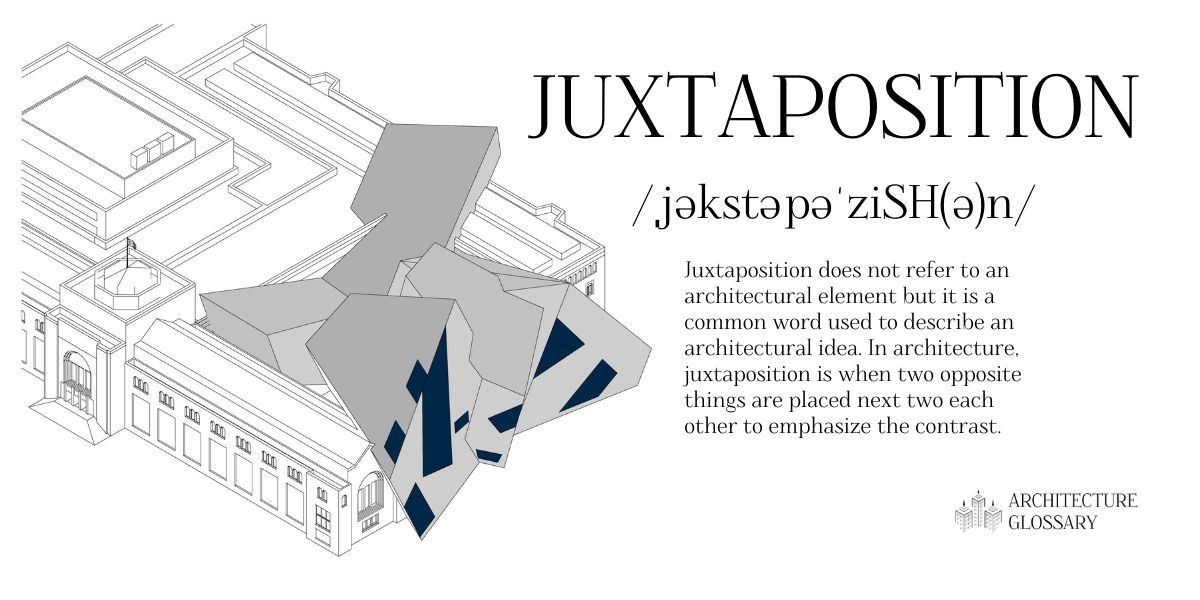
Drawings: Samantha Pires/My Modern Met
Juxtaposition does not refer to an architectural element but it is a common word used to describe an architectural idea. In architecture, juxtaposition is when two opposite things are placed next two each other to emphasize the contrast.
Keystone
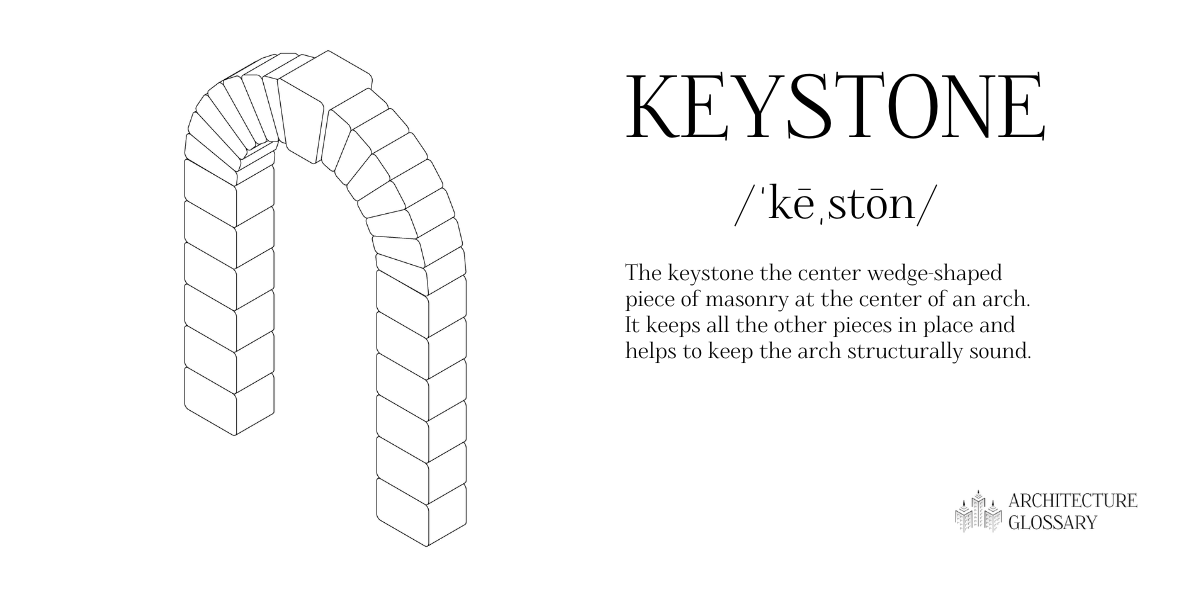
Drawings: Samantha Pires/My Modern Met
The keystone is the center wedge-shaped piece of masonry at the center of an arch. It keeps all the other pieces in place and helps to keep the arch structurally sound.
Lintel
A lintel is a horizontal block that spans an opening. It is often found over doors or windows.
Louvers

Drawings: Samantha Pires/My Modern Met
Louvers are a design element used to keep light from entering a building. Louvers come in many shapes and sizes and often become a major part of the design intent.
Maqsurah
A maqsurah is a common mosque element. It is a small enclosed area near the mihrab—a term also defined on this list. The maqsurah was reserved for rulers visiting the mosque in order to protect them from any potential attacks while praying.
Massing
A massing is the general size and shape of a building. Massings are often the first step in a conceptual study when designers define the general boundaries of the building. The term massing is used later in the design process to describe architectural volumes.
Mezzanine
A mezzanine is a half floor in a building. Mezzanines are generally open to an atrium that is typically a double-height space or taller.
Mihrab
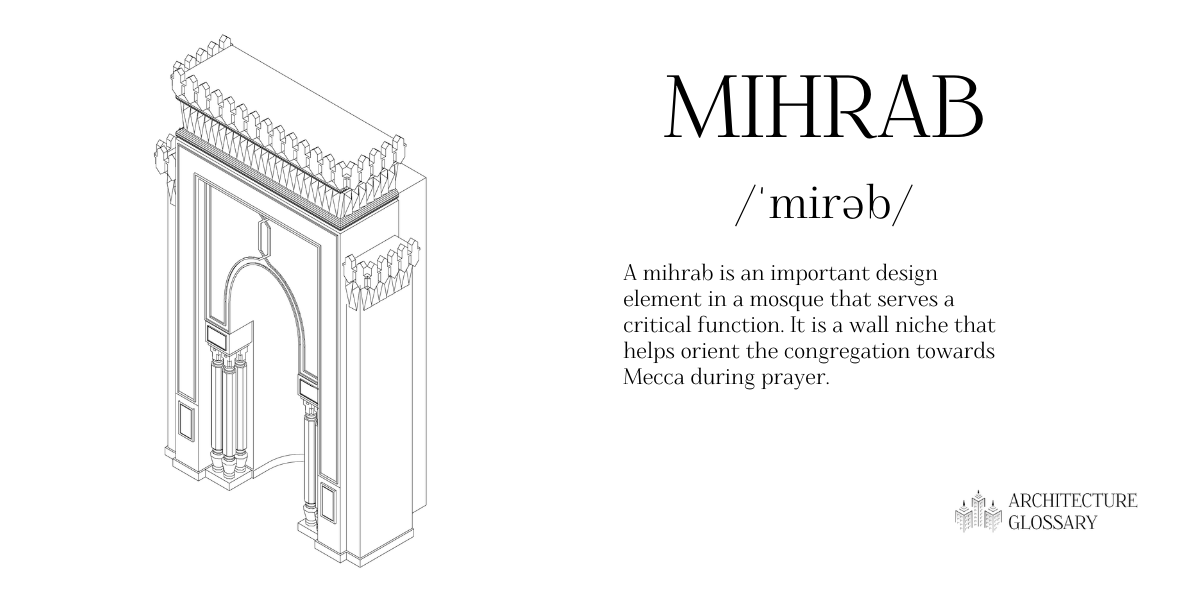
Drawings: Samantha Pires/My Modern Met
A mihrab is an important design element in a mosque that serves a critical function. It is a wall niche that helps orient the congregation towards Mecca during prayer.
Minaret
A minaret is a traditional tower in or near a mosque. It is an iconic design element of the mosque typology but it also serves multiple functions. Minarets are used to call Muslims to come and pray at the time of prayer.
Modern Architecture
Modern architecture does not just mean the architecture of today. It refers to a specific architectural movement in which architects attempted to find a universal language of design that would suit everyone. There were a few different specific kinds of modernism, but all followed the basic idea of using ideas of function to define architecture.
If you want to learn more about Modern Architecture, be sure to read our guide: Get a Crash Course in Modernist Architecture With 8 Styles That Define the Movement
Modular
Architecture based on a modular concept uses a set system of repeated units aggregated to create a finished project. For example, a tower may use a modular system where each unit in the system is a set of units. These units can be stacked in interesting ways.
Monumental
Architecture that is monumental has an air of permanence or heaviness. Famous architect Louis Kahn described monumental architecture as inspiring a spiritual quality.
Mullion
Mullions are the vertical members that separate portions of a window, screen, or curtain wall. Mullions support the structure of the window and allow for smaller portions of glass.
Nave
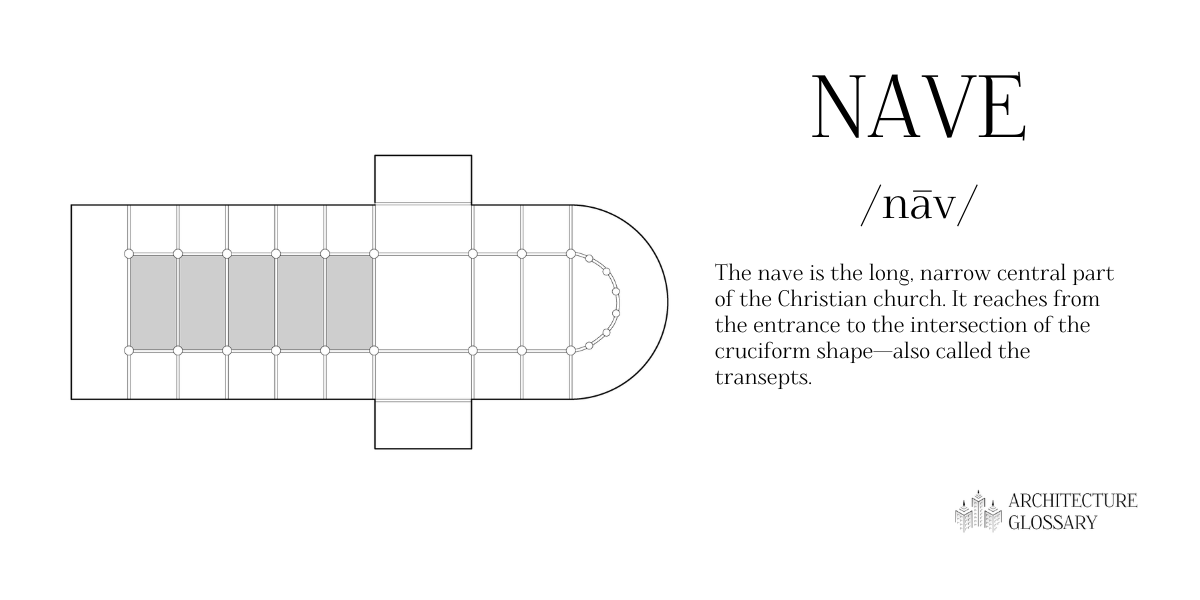
Drawings: Samantha Pires/My Modern Met
The nave is the long, narrow central part of the Christian church. It reaches from the entrance to the intersection of the cruciform shape—also called the transepts.
Neo
“Neo” precedes a few architectural styles and means a reemergence of a style back in to popularity. For example, neoclassical architecture is a contemporary style that imitates the original classical works of Ancient Greek and Rome.
Oculus
An oculus is a circular opening at the center of a dome. One of the most popular examples of an oculus is in the Pantheon.
If you want to learn more about the Pantheon, be sure to read our article: 9 Facts About the Pantheon, the Iconic Roman Church That Barely Survived the Dark Ages
Ornamentation

Drawings: Samantha Pires/My Modern Met
Ornamentation is simply any form of decoration on a piece of architecture. Ornamentation is often embedded in structures, windows, or other pieces of architecture. In some styles, it is difficult to distinguish what is ornamentation and what is pure function.
Palazzo
The palazzo is an architectural type in the 19th and 20th centuries. They are large monumental buildings inspired by the palaces of wealthy Italian Renaissance families.
Parapet
A parapet is a low boundary along the edge of a roof that acts as a railing for people that might fall over the edge.
Parti
The word parti comes from “parti pris” which means “decision taken.” A parti is a concept or scheme that describes the concept behind an architectural project. A parti typically takes the form of a diagram.
Pavilion
In architecture, a pavilion is an informal structure that is often temporary. They are sometimes architectural installations or additions to gardens or public areas.
Picturesque
Picturesque architecture is a style from the late-18th and early-19th centuries that comes from the related artistic style. It considered architecture in combination with landscape for one composed scene.
Pilotis
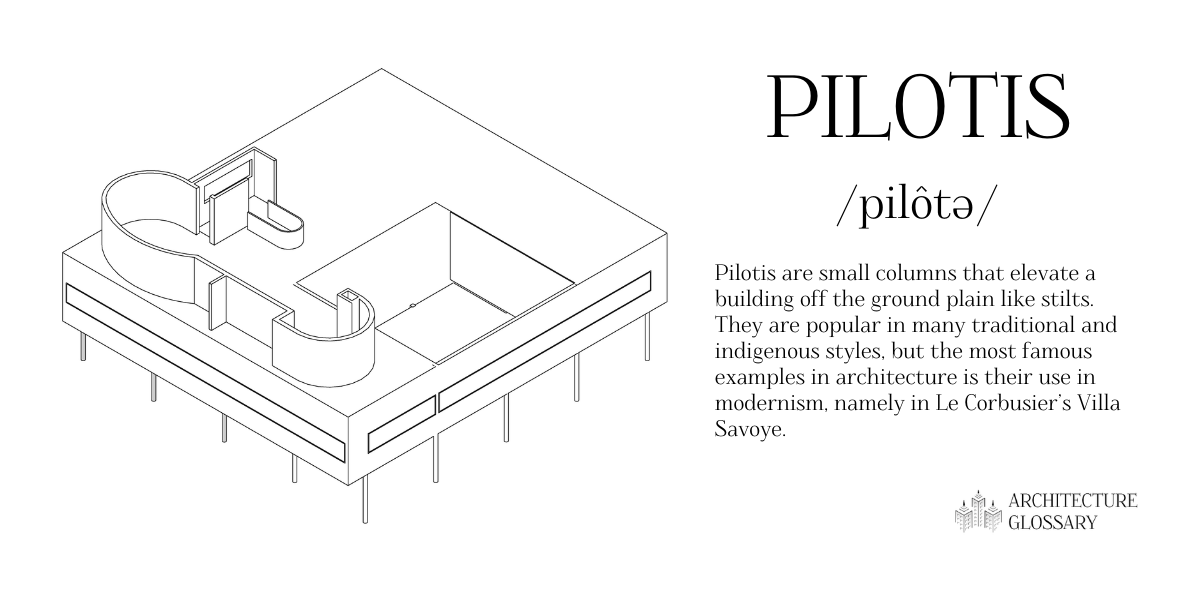
Drawings: Samantha Pires/My Modern Met
Pilotis are small columns that elevate a building off the ground plain like stilts. They are popular in many traditional and indigenous styles, but the most famous examples in architecture is their use in modernism, namely in Le Corbusier’s Villa Savoye.
Plinth
A plinth is an elevated pedestal that helps to distribute weight and create a grander appearance for a building or a portion of a building.
Portico
A portico is a porch at the entrance of a Classical building. The portico is covered by a roof that is held up by columns. It is a form of a canopy, another term defined on this list.
Postmodern Architecture
Postmodern architecture is a design style that came about in the '60s as a response to modernism. The style was playful and quirky because it believed that modernists were too boring and focused on function. It was characterized by fun colors and interesting geometries.
If you want to learn more about Postmodern architecture, be sure to read our guide: 5 Postmodernist Buildings That Capture the Movement’s Playful Side
Procession
In architecture, a procession is the path one takes while entering or passing through a work. It is often a path that was carefully considered as a series of framed perspectives. One example of an important procession in an architectural work is the procession followed in churches by priests reaching the alter.
Program
In architecture, building program refers to the function of a space. A cultural center may include building programs like classrooms, event spaces, and a cafeteria.
A program can also refer to a computer program used to 3D model an architecture project or complete architecture drawings.
Rectilinear
Rectilinear designs are made up of mostly straight lines and right angles. It is often understood as the opposite of curvilinear which is also defined on this list.
Renaissance
Renaissance architecture was the design style of a period of European revival. Much of the style was inspired by Classical architecture. The characteristics of Renaissance architecture focused on proportions in the search for perfect beauty. They studied the human body in comparison to buildings and attempted to create a perfect work through integration of architecture, art, and sculpture.
Rib Vault

Drawings: Samantha Pires/My Modern Met
A rib vault is a type of vault made up of crossed diagonal arches that look like ribs. Rib vaults are extremely popular structural ideas found throughout many styles.
Romanesque
Romanesque architecture is a historic style popular for a range of time in medieval Europe. The style is similar to Roman and Byzantine architecture and features characteristics of both, including round arches, groin vaults, and plenty of art and sculpture.
Screen
In architecture, a screen is a façade element that is often partially transparent or porous. Screens can be a masonry wall of a special masonry unit, a rain screen system, or a similar screen-like system.
Section
A section is an important architectural drawing that allows us to cut through a building and see what it looks like inside. This drawing is important because it allows us a view what we could never have seen in real life and it allows us to understand the relationship between different programs.
Setback
In architecture, a setback is when a building is recessed back. This could refer to a setback on street level for a lawn or plaza between the building and the sidewalk. A setback could also refer to when a portion of a building is setback from the level below it. Many NYC towers include setbacks as they grow taller.
Solar Gain
Solar gain is the amount of sunlight that enters a building or hits a material. It is an important consideration in architecture because sunlight brings in natural light, but it also heats the building. Minimizing solar gain is often necessary to improve the cooling of a building.
Spire

Drawings: Samantha Pires/My Modern Met
A spire is the ornamental tip of a tower. Though they are typically associated with Gothic architecture and other older styles, spires are still used in contemporary buildings, especially skyscrapers.
Stoop
In architecture, a stoop is a porch with steps at the entrance of a building. Since stoops are typically found in front of houses or apartment buildings, they act as an informal public space. Stoops are a great example of architecture playing an important cultural role.
Tracery
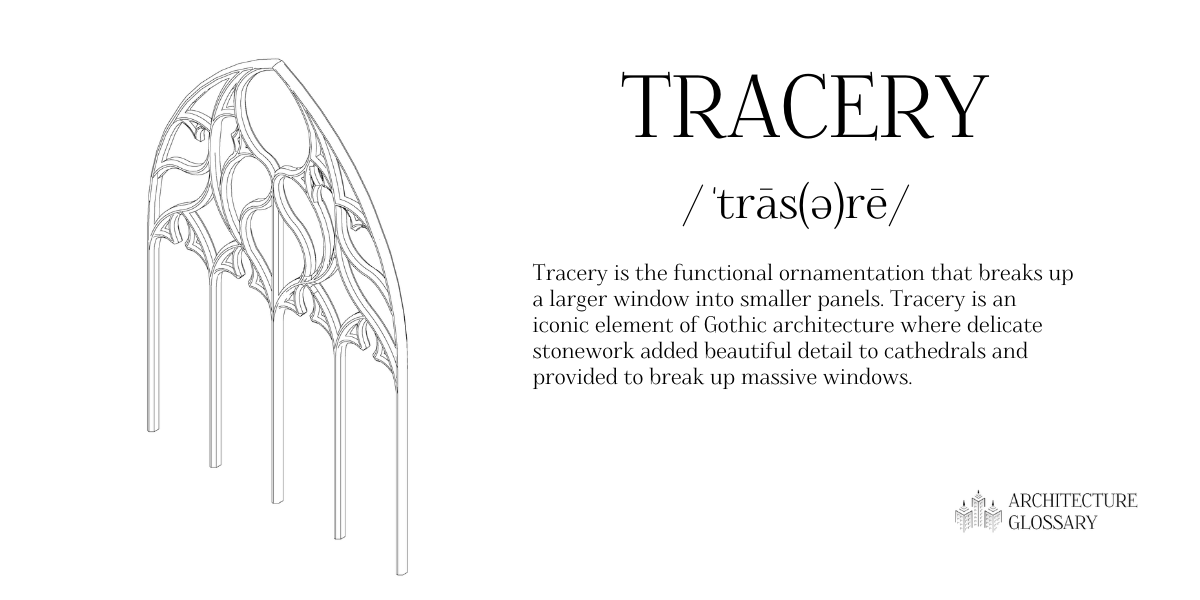
Drawings: Samantha Pires/My Modern Met
Tracery is the functional ornamentation that breaks up a larger window into smaller panels. Tracery is an iconic element of Gothic architecture where delicate stonework adds beautiful detail to cathedrals and visually breaks up massive windows.
Turret
A turret is a small tower typically at the corner of a building. Turrets are an iconic feature of castles since they allowed for guards to look out in defense of the building. They are also sometimes used in homes and other building types purely for aesthetics.
Typology
Typology is the way to classify things according to similar characteristics. In architecture, typology is a common term that helps characterize different types of buildings by styles, programs, and other similarities.
Vault
A vault is a self-supported arched extrusion. There are many forms of vaults that are defined by how the arch is continued. On this list, we define barrel vault, groin vault, and rib vault.
Veneer
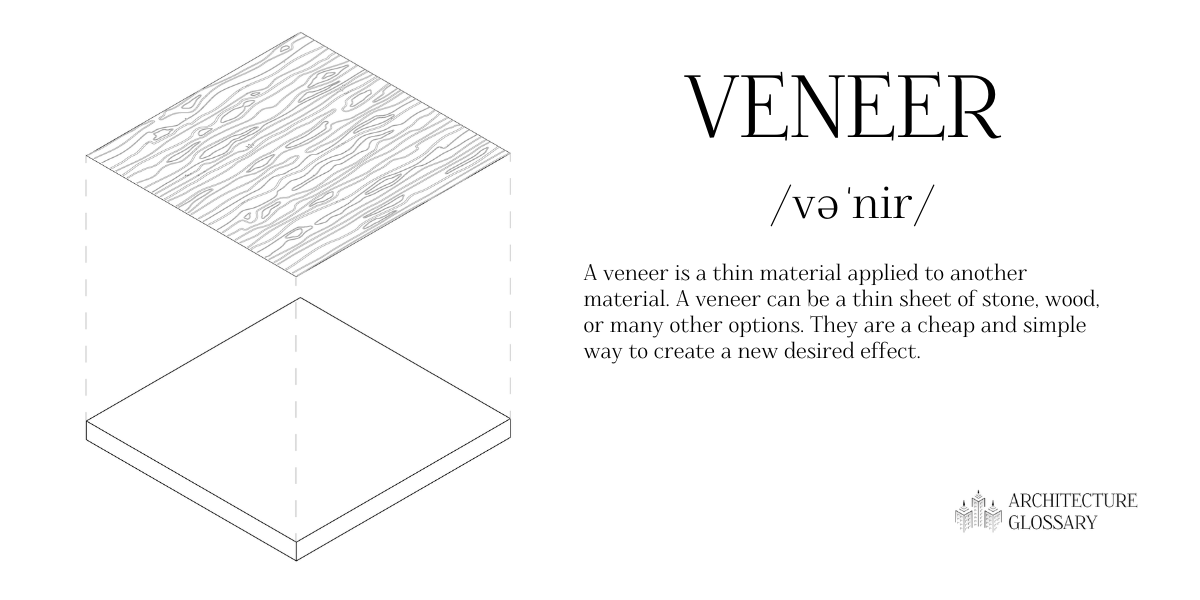
Drawings: Samantha Pires/My Modern Met
A veneer is a thin material applied to another material. A veneer can be a thin sheet of stone, wood, or many other options. They are a cheap and simple way to create a new desired effect.
Vernacular
Vernacular architecture is any style that is native to a specific area and time. Vernacular architecture is the opposite of the International style, which sought to find common design ideas that worked anywhere in the world. Vernacular architecture is based on tradition and often relies on materials and knowledge from the area.
Vestibule
A vestibule is a small entrance area that people pass through before reaching a larger space. Vestibules help to reduce the amount of heat lost every time a door is opened by allowing for a gap before conditioned air is let out of the building. This process saves money in the conditioning of a space and is also more environmentally friendly.
Victorian Architecture
Victorian architecture is a style popular during the end of the 19th century. The name Victorian comes from Queen Victoria, since she was in power at the height of the style’s popularity. Victorian architecture is characterized by pitched roofs, colorful brick, ornate gables, and the tall, iconic turrets.
Visualization
Architectural visualization, or arch viz as it is sometimes called, is the process of creating 2D images of a 3D model. It is used as a presentation tool during the design and construction of an architectural work.
Ziggurat

Drawings: Samantha Pires/My Modern Met
A ziggurat is a common building type in Ancient Mesopotamia that is similar to a pyramid. Ziggurats are made up of terraces that recede as they get closer to the top. Monumental stairs are often included on each side. Ziggurats were designed to bring people closer to heaven.
Related Articles:
20 Documentaries About Famous Architects and Great Architecture
15 Must-See TV Shows for Architects and Architecture Lovers
25 Books That Every Architect and Architecture Lover Should Read
15+ Architecture-Inspired Mugs for Design Lovers
READ: 100 Architecture Terms That Will Help You Describe Buildings Better

0 Commentaires